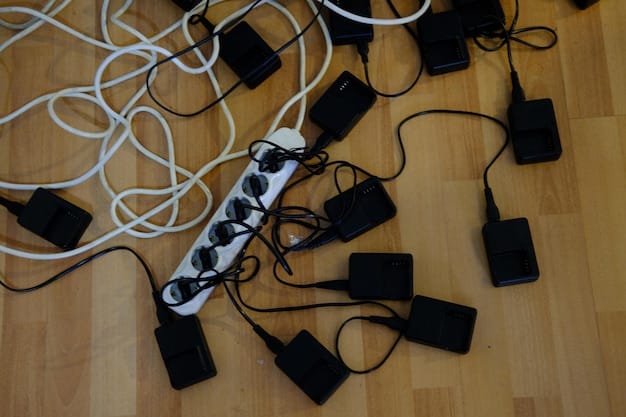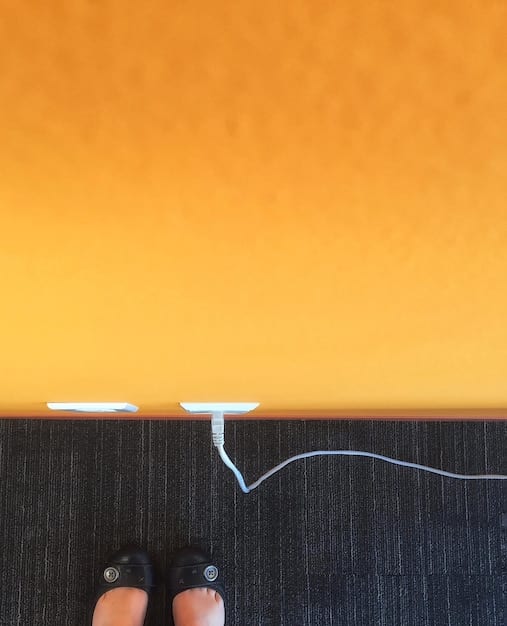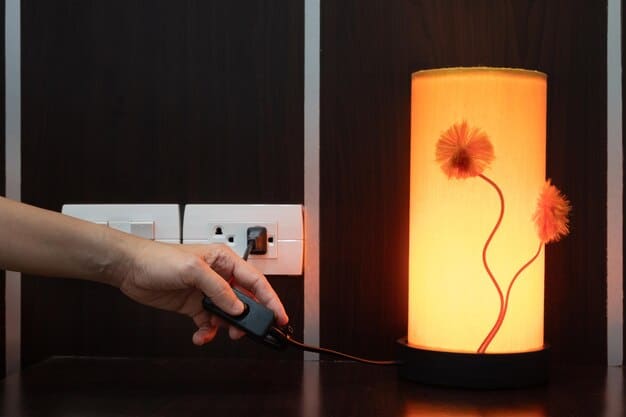Unplug and Save: Reduce Phantom Energy Costs by $200 a Year

Phantom energy loads, also known as vampire power, drain electricity even when devices are turned off, costing the average US household around $200 annually; simple actions like unplugging devices and using power strips can help minimize this waste and save money.
Are you unknowingly throwing money away every month? The culprit might be lurking in plain sight: your household appliances and electronics, silently draining power even when they’re switched off. It’s time to **Unplug and Save: How Phantom Energy Loads Are Costing You $200 a Year**—and what you can do about it.
Understanding Phantom Energy Loads
Phantom energy loads, also known as vampire power, standby power, or leaking electricity, refer to the electricity consumed by electronic devices and appliances when they are switched off or in standby mode. These seemingly insignificant drains can add up over time, leading to a noticeable increase in your energy bill. It’s a hidden cost that many homeowners are unaware of, contributing significantly to overall energy waste.
What Devices Are the Biggest Offenders?
Several common household devices are notorious for their phantom energy consumption. Understanding which appliances are the biggest culprits can help you prioritize your energy-saving efforts.
- Televisions and Media Devices: TVs, DVD players, and gaming consoles often remain in standby mode, ready to be turned on instantly.
- Computers and Peripherals: Desktops, laptops, printers, and chargers continue to draw power even when not in use.
- Kitchen Appliances: Microwaves, coffee makers, and toasters frequently display the time or maintain a standby mode, consuming energy.
- Chargers: Phone chargers, laptop chargers, and other adapters keep drawing power as long as they are plugged into the outlet even they are not attached to any device.
Why Do Devices Draw Power When Off?
Modern electronic devices often incorporate features that require continuous power, even when the device appears to be off. Remote controls, digital displays, and internal clocks all need a small amount of electricity to function. Additionally, some devices maintain a “ready” state to facilitate quicker start-up times, further contributing to phantom energy consumption.
Understanding the nature and sources of phantom energy is the first step toward reducing your energy consumption and saving money. By identifying the devices that contribute the most to these hidden loads, you can start implementing strategies to minimize their impact. This includes unplugging devices, using power strips, and opting for energy-efficient alternatives.

Quantifying the Cost: How Much Are You Losing?
Understanding the impact of phantom energy on your wallet requires a look at how much these hidden drains cost. The exact amount varies based on your local energy rates and the number and type of devices you have in your home. However, the cumulative impact can be significant.
Calculating Your Phantom Energy Costs
Measuring phantom energy consumption involve using a device to measure kilowatt hours and calculating your costs based on local energy rates.
- Use a Kill-A-Watt Meter: You can plug your appliances and electronic devices and it will measure how much energy it’s consuming when it is ‘off’.
- Check your electric bill: This allows you to know how much you are being charge per kilowatt hour(kWh).
- Calculate your rate: Multiply the kWh used by the the device when it’s off by the electric rate. Take that total amount and multiply by 24 (hours) to get the daily cost, and then by 365 for yearly cost.
Estimating Annual Losses
According to the U.S. Department of Energy, phantom energy loads can account for as much as 10% of a household’s annual energy consumption. For the average household, this can translate to around $200 per year. However, in some homes with more electronic devices, these costs can be even higher.
Real-Life Examples of Costly Devices
Consider a few common examples to illustrate the potential costs:
- Gaming Consoles: A gaming console in standby mode can consume around 1 watt per hour, costing you roughly $1.50 per year.
- Televisions: Modern TVs can use between 2 to 10 watts in standby, adding up to $3 to $15 annually.
- Phone Chargers: Although individual chargers consume very little power, multiple chargers plugged in around the home can quickly add up.
By understanding the potential costs associated with phantom energy, you can gain a clearer picture of the financial impact of these hidden drains. Knowledge is a great motivation to take action.
Simple Steps to Reduce Phantom Loads
Reducing phantom energy loads doesn’t require complex solutions or significant lifestyle changes. Many simple and effective strategies can minimize energy waste and save money. Even just adopting one of these steps can impact your energy consumption.
Unplug Devices When Not in Use
The most straightforward way to eliminate phantom energy consumption is to unplug devices when they are not in use. This cuts off the power supply completely, ensuring that no energy is being wasted. Make it a habit to unplug chargers, kitchen appliances, and other electronics when you’re finished using them. This can immediately reduce your energy usage and bring down your bill.
Use Power Strips as Central Control Points
Power strips offer an easy way to manage multiple devices at once. By plugging several devices into a single power strip, you can switch them all off simultaneously. This is particularly useful for entertainment centers, home offices, and other areas with multiple electronic devices. Turn off the power strip when all devices are not in use to minimize phantom energy consumption.
Invest in Energy-Efficient Electronics
When purchasing new electronic devices, look for models with the Energy Star label. Energy Star-certified products are designed to be more energy-efficient than standard models, both when in use and in standby mode. Although these devices may cost a little more upfront, they could save you money in the long run through reduced energy consumption.
Taking simple actions like unplugging devices, using power strips, and investing in energy-efficient electronics can significantly reduce phantom energy loads and lower your energy bill. Every small changes contribute to a more sustainable and cost-effective lifestyle. By implementing these best practices, you can make a positive impact on the environment and your wallet. You can also set a routine reminder to check your energy consumption.
Advanced Strategies for Minimizing Energy Waste
While unplugging devices and using power strips are effective ways to reduce phantom loads, other more advanced strategies can further minimize energy consumption. These strategies involve being more proactive about your energy usage and making informed decisions about your electronic devices.
Smart Plugs and Automation
Smart plugs offer a convenient way to control your devices remotely. These plugs connect to your home’s Wi-Fi network, allowing you to turn devices on or off from your smartphone or tablet. You can also set schedules to automatically switch off devices at certain times, ensuring that they are not consuming phantom energy overnight or when you’re away from home.
Energy Monitoring Systems
Comprehensive energy monitoring systems provide detailed insights into your energy consumption patterns. These systems track the energy usage of individual devices and appliances, helping you identify which ones are contributing the most to phantom loads. You can use this information to target specific devices for energy-saving measures.
Adjusting Device Settings
Many electronic devices have settings that can be adjusted to reduce standby power consumption. For example, you can enable sleep mode on your computer, which reduces energy usage when the device is idle. Similarly, you can turn off the quick start-up feature on your TV. This helps reduce the amount of power consumed in standby mode. All these can make significant impact when talking about your energy consumption.
Implementing advanced strategies requires a more proactive approach to energy management, but the additional effort can yield significant savings. By leveraging smart technology, investing in energy monitoring systems, and optimizing device settings, you can further reduce phantom energy loads and minimize your environmental footprint. Furthermore, you should encourage other people to be more aware of their carbon footprint.

The Environmental Impact of Phantom Loads
Beyond the financial costs, phantom energy loads also have significant environmental implications. The electricity wasted by these hidden drains contributes to increased greenhouse gas emissions and the depletion of natural resources. Understanding the environmental impact can provide further motivation to reduce phantom loads.
Increased Carbon Footprint
The power plants generate electricity, often burning fossil fuels. When devices draw power unnecessarily, it increases the demand for electricity, leading to higher emissions of carbon dioxide and other greenhouse gases. The result is that you aren’t just wasting money, you’re contributing to air polution.
Depletion of Natural Resources
Generating electricity requires the use of natural resources, such as coal, natural gas, and water. By reducing energy waste, we can conserve these resources and minimize the environmental damage associated with their extraction and processing. We can prevent deforeststion and mining of the Earth’s land.
Promoting Sustainable Practices
Reducing phantom energy consumption is more than just a short-term solution for saving money. It promotes energy conservation and responsible energy use, contributing to a more sustainable future for generations to come. This may also influence more people to adopt more responsible and green actions.
Phantom energy loads have far-reaching environmental consequences, from increasing greenhouse gas emissions to depleting natural resources. By taking steps to reduce these drains, you can help mitigate your environmental impact and promote energy conservation globally. Every small effort contributes to a more sustainable and livable planet.
Tips for a Comprehensive Home Energy Audit
While addressing phantom energy loads is essential, this is the first step you can take towards lowering your energy bill. A comprehensive home energy audit can provide a holistic assessment of your energy consumption and highlight areas for improvement. This can provide you with the motivation to change a number of things.
Conducting a DIY Energy Audit
You can start with a do-it-yourself energy audit to identify potential sources of energy loss and waste in your home. A do-it-yourself audit requires no special skills or experience. You can perform these tasks by just doing a walk-through of your home.
- Check for Air Leaks: You can seal windows with weather stripping.
- Check your insulation: Make sure your attic is well insulated to prevent conductive heat flow.
- Examine appliances: Perform a visual walk throught of your home and make sure all of your appliances are energy star certified.
Professional Energy Audits
For a more in-depth assessment, you can hire a professional energy auditor. These experts use specialized equipment, such as infrared cameras and blower door tests, to detect hidden energy leaks and insulation gaps. A professional auditor can provide you with specific recommendations for improving your home’s energy efficiency.
Implementing Audit Recommendations
Once you have completed an energy audit, it’s important to implement the recommended improvements. This may involve sealing air leaks, adding insulation, upgrading appliances, or making other energy-saving changes. Prioritize the most impactful improvements to maximize your energy savings.
A comprehensive home energy audit provides valuable insights into your energy consumption patterns and helps you identify opportunities to save energy and reduce costs. Whether you conduct a DIY audit or hire a professional, this assessment is a crucial step toward creating a more energy-efficient and sustainable home.
| Key Point | Brief Description |
|---|---|
| 💡 Phantom Energy | Electricity used by devices when off or in standby. |
| 🔌 Unplug Devices | Cut off power completely when not in use. |
| 🔋 Power Strips | Easily turn off multiple devices at once. |
| 🌱 Energy Audit | Assess and improve your home’s energy efficiency. |
FAQ Section
▼
Phantom energy loads refer to the electricity that electronic devices and appliances consume even when they are turned off or in standby mode, contributing to energy waste.
▼
The average US household can save around $200 per year by minimizing phantom energy loads through simple actions like unplugging devices and using power strips.
▼
Common offenders include televisions, gaming consoles, computers, kitchen appliances (such as microwaves), and chargers, all of which continue to draw power in standby mode.
▼
Simple strategies include unplugging devices when not in use, using power strips to switch off multiple devices at once, and investing in Energy Star-certified electronics.
▼
Phantom energy loads contribute to increased greenhouse gas emissions and the depletion of natural resources, as power plants often need to burn more fossil fuels to compensate for this wasted energy.
Conclusion
Reducing phantom energy loads is a simple way to save money, lower your carbon footprint, and promote a more sustainable lifestyle. Start unplugging devices, using power strips, and investing in energy-efficient electronics today and save for tomorrow!





